This is an automatically translated article.
Zonisamide is an antiepileptic drug, often used alone or in combination with other drugs to treat partial seizures. The use of the drug should be monitored because of the risk of side effects of Zonisamide affecting the patient's body.1. What does Zonisamide do?
Zonisamide is an antiepileptic drug, prepared in many different forms and strengths such as 25, 50, 100 mg hard capsules; 20 mg/ml oral suspension.
Zonisamide is a derivative of Benzisoxazole, an antiepileptic drug with weak carbonic anhydrase activity.
The mechanism of action of Zonisamide has not been fully studied. Zonisamide can act on voltage-sensitive calcium and sodium channels, disrupting synchronous activation of neurons, reducing the propagation of seizures, and thereby helping to prevent seizures. next sutra. Zonisamide also has a GABA-mediated inhibitory effect on neurons.
2. Indications and contraindications of the drug Zonisamide
Indications:
Zonisamide can be used as monotherapy or as an adjunct in the treatment of focal-onset seizures (partial seizures) in adults, adolescents and children 6 years of age and older. up. Do not use Zonisamide for the following cases:
Hypersensitivity to the active ingredient Zonisamide, the substances of the Sulphonamide group or to any of the excipients of the drug. Peanut allergy or soy allergy.
3. Dosage and how to use Zonisamide
3.1. Dosage of the drug Zonisamide
Adults:
Monotherapy: For newly diagnosed patients:
Weeks 1 and 2: Use 100 mg/time/day. Weeks 3 and 4: Use 200 mg/time/day. Weeks 5 and 6: Use 300 mg/time/day Maintenance dose is 300 mg/time/day If higher dose is required: Increase gradually from 100 mg to a maximum of 500 mg dose increments every 2 weeks . Adjunctive therapy with CYP3A4 inducers:
Weeks 1 and 2: Orally 25 mg/day Weeks 3 and 4: Orally 50 mg/day Weeks 5 and 6: Increase by 100 mg/day every 1 weeks to reach maintenance dose. Maintenance dose: Oral 300-500 mg/day, can be divided into 1 or 2 times/day. Adjunctive therapy with a non-CYP3A4 inducer:
Weeks 1 and 2: Orally 25mg twice a day Weeks 3 and 4: Orally 50mg twice a day Weeks 5 and 6: Increase by 100 mg/day every 2 weeks to reach maintenance dose. Maintenance dose: Oral 300-500 mg/day, can be divided into 1 or 2 times/day. Some other patients may respond to lower doses. Elderly: Information on drug use is limited.
Children: Dosage is increased gradually in stages and depends on the weight of the patient. The safety and effectiveness of Zonisamide in children under 6 years of age and those under 20 kg has not been established.
Hepatic impairment: The use of the drug in patients with hepatic impairment has not been studied. It is therefore not recommended for use in patients with severe hepatic impairment. Care should be taken when administering therapy to patients with mild to moderate hepatic impairment and dose adjustment may be required when administered.
Renal Impairment: Zonisamide and its metabolites are eliminated by the kidneys; therefore, the drug should be discontinued in patients with acute renal failure or when serum creatinine is markedly elevated. Dosage adjustment may be necessary for patients with renal impairment.
3.2. How to use Zonisamide
The drug is used orally or by injection, depending on the form of the preparation.
When stopping treatment with Zonisamide, the dose should be reduced gradually every week, depending on the weight:
For people 20-28 kg: The dose reduction level per week is 25-50 mg / time / day. For people 29-41 kg: Reduce dose weekly by 50-75 mg/time/day. People over 42kg: The weekly reduction is 100mg/time/day 3.3. Overdosage and missed dose of Zonisamide
Overdose: There have been cases of accidental and intentional overdose in patients. In some cases, overdose may be asymptomatic, especially with vomiting or immediate gastric lavage. In other cases, overdose may cause symptoms such as drowsiness, gastritis, nausea, nystagmus, myoclonic tremor, severe possibly coma, bradycardia, decreased renal function, hypotension and respiratory depression. There is no specific antidote for Zonisamide overdose, if a short-term overdose is suspected, it should be cleared from the stomach by gastric lavage or induction of vomiting. support. Missed dose: If you forget to take a dose, take this medicine as soon as you remember. However, if it is almost time for your next dose, skip the missed dose and continue taking your next dose at the scheduled time.
4. Zonisamide side effects
Like other drugs, the use of Zonisamide can also cause side effects including:
Common:
Anorexia, agitation or confusion, irritability, weakness, ataxia, dizziness face, memory impairment, drowsiness; Double vision, bruises, anaphylaxis, anxiety, insomnia, psychosis, neurasthenia, speech disorder, nystagmus; Lethargy, tremors, abdominal pain, digestive disorders causing diarrhea or constipation, nausea; Rash, itching, hair loss, kidney stones, feeling tired, weight loss, peripheral edema, fever or flu-like symptoms. The test showed a decrease in bicarbonate. Uncommon side effects:
Pneumonia, urinary tract infection, hypokalemia, anger, aggression, suicide, convulsions, vomiting, cholecystitis, gallstones, kidney stones. Rare:
Aplastic anemia, causing decreased blood count, thrombocytopenia, agranulocytosis, increased white blood cell count, lymphadenopathy; Severe hypersensitivity such as anaphylaxis, rash, metabolic acidosis, renal tubular acidosis; Hallucinations, coma, myasthenia gravis, convulsions, neuroleptic malignant syndrome, status epilepticus. Closed-angle glaucoma, visual impairment, eye pain; Respiratory dysfunction, pneumonia, hepatocellular injury, pancreatitis, Stevens-Johnson syndrome, toxic epidermal necrolysis, liver dysfunction, heat shock. Decreased sweating, rhabdomyolysis, renal failure, erythema. Changes on the test increased creatine phosphokinase, increased blood creatinine, increased blood urea. When experiencing side effects of the drug, you need to tell your doctor or go to a medical facility for treatment.
5. Notes when using Zonisamide
Treatment with Zonisamide can cause serious rashes, including cases of Stevens-Johnson syndrome. Discontinuation of Zonisamide should be considered in patients who develop an unexplained rash. Discontinuation of Zonisamide in epileptic patients should be done by gradually reducing the dose as directed, avoiding abrupt discontinuation to reduce the possibility of convulsions. An ophthalmic syndrome including acute myopia associated with secondary angle-closure glaucoma has been reported in both adult and pediatric patients with zonisamide. Early onset of symptoms may occur within hours to weeks of starting treatment. Glaucoma is a serious disease of any cause that, if left untreated, can lead to serious sequelae including permanent vision loss. Zonisamide should be treated with caution in patients with a history of eye disorders. Monitoring and early examination for early detection of drug-induced glaucoma Patients should be monitored for signs such as suicidal ideation and behavior while taking medication. Because the drug can cause depression or suicidal ideation, although it is rare. Zonisamide use may increase the risk of kidney stones with associated symptoms such as renal colic or lower quadrant pain. Drinking plenty of water may help reduce the risk of kidney stone formation, especially in patients with predisposing risk factors for the disease. In patients receiving Zonisamide who develop clinical signs and symptoms of pancreatitis, it is recommended that patients monitor pancreatic lipase and amylase levels. If pancreatitis is evident but the cause is unknown, discontinuation of Zonisamide should be considered. For patients receiving Zonisamide with symptoms such as myalgia, severe muscle weakness, should be evaluated for signs of muscle damage through testing such as serum creatine phosphokinase and aldolase levels. Women of childbearing age should use effective contraception during treatment and use contraception for 1 month after stopping Zonisamide. Pregnancy: Zonisamide is not indicated for use in pregnancy unless clearly needed or when the potential benefit greatly outweighs the risk to the fetus. Patients should be fully informed of the potential risk of harm to the fetus if the drug is taken. Precautions for use in breast-feeding women: Zonisamide is excreted in human milk, with concentrations in breast milk similar to those in maternal plasma. A decision must be made between stopping breastfeeding or stopping Zonisamide treatment. Due to the prolonged retention time of Zonisamide in the body, breast-feeding should not be done within 1 month of the end of treatment with Zonisamide.
6. Drug interactions
Zonisamide interactions with other drugs reported include:
Caution should be taken when co-administering Zonisamide with carbonic anhydrase inhibitors such as topiramate, acetazolamide in adults and this combination should not be used in pediatric patients . Zonisamide should be treated with caution in patients receiving drugs that are substrates of P-gp (Digoxin, Quinidine). If co-administration of Zonisamide with inducers of CYP3A4 enzymes (Phenytoin, Carbamazepine, Phenobarbitone) is required, the patient should be closely monitored and the dose adjusted as necessary. Zonisamide is an antiepileptic drug that can be used in people over 6 years of age. The use of the drug should be carefully considered and monitored by a qualified physician. If there is any abnormality, please notify your doctor for advice.
Please dial HOTLINE for more information or register for an appointment HERE. Download MyVinmec app to make appointments faster and to manage your bookings easily.













